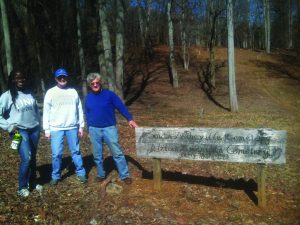By Valerie McMurray – [email protected] – Staff Writer

Photo by Valerie McMurray – Staff Writer
In 1989, the South Asheville Colored Cemetery Project began as a last-resort effort to retain the history of African-Americans in the region. At the time, just seven local residents, most of them in their 80s and 90s, remained to speak of the first and largest public place where African-Americans were allowed to be buried. Since its closure in 1943, no one remained in charge of its caretaking and the cemetery became all but forgotten.
Charles Gibson, an Asheville resident, recalled as a boy, it was common to fall into the depressions left by unmanaged graves while playing in the cemetery with his friends. Although the graveyard is thought to be filled to capacity, only a small percentage of the plots are marked with tombstones. Gibson served as a part of the initial community movement to restore and undertake maintenance.
The next project involved uncovering the cemetery itself. Since 1998 numerous groups of volunteers chipped away at the once-untraversable plot.
“The property was choked with leaves, brush and trees, and graves were hard to find,” said Pat Griffin, an association board member.
There has never been an exclusive group of renovators; instead, volunteers included students, church leaders, various community members and eight teams of AmeriCorps workers.
Ellen Pearson, an associate professor of history at UNC Asheville, became involved 10 years ago through the now-defunct Bulldog day of service projects, once part of orientation for incoming freshmen. She contributes as a regular volunteer, visiting with student groups a few times each year.
“It’s a rich part of Asheville’s history that was literally covered up for years – overgrown,” Pearson said.
Nambi Ndugga, a senior at UNCA, hosted a panel discussion, “African-Americans in Asheville-Buncombe County,” in Ramsey Library on Feb. 20. The talk focused on the South Asheville Cemetery, intending to raise awareness about the local historic site and encouraging participation in the ongoing project.
Pearson and Griffin were featured alongside Warren Wilson College professors David Moore and Jeff Keith, WWC senior Nadiya Marrengulye, Rev. Allen Smith of the Kenilworth Presbyterian Church and local residents. Piecing together the cemetery’s history proved to be a collaborative effort. It was not all based on local lore. Moore, who teaches archaeology, led an effort to map the burial sites, and Keith currently teaches a course centered around the cemetery as a service-learning project, using the landscape as a historical text.
According to Moore, the cemetery contains 1,962 graves and approximately 110 have gravestones with names on them. Approximately half of the rest have some kind of marker, while some are marked only with a fieldstone.
Marrengulye presented a detailed account of the life of the cemetery’s first caretaker, George Avery, a former slave owned by William Wallace McDowell. A blacksmith, bricklayer and Civil War veteran, Avery is buried there.
On Feb. 22, Pearson and Ndugga met with David Quinn, a planning consultant who has been involved since 1998, and other volunteers to do more renovation work. The group said they plan to install a fence in the near future.

















